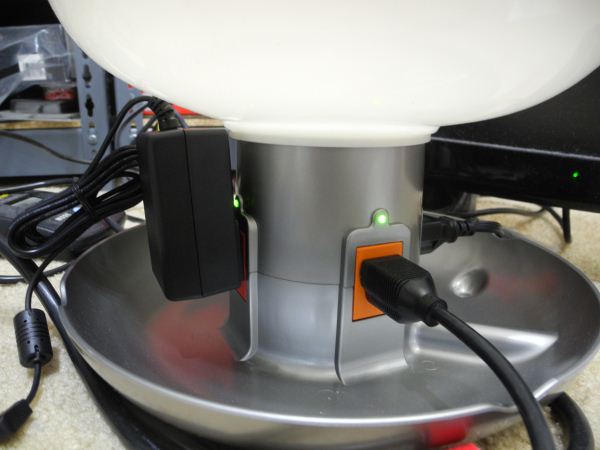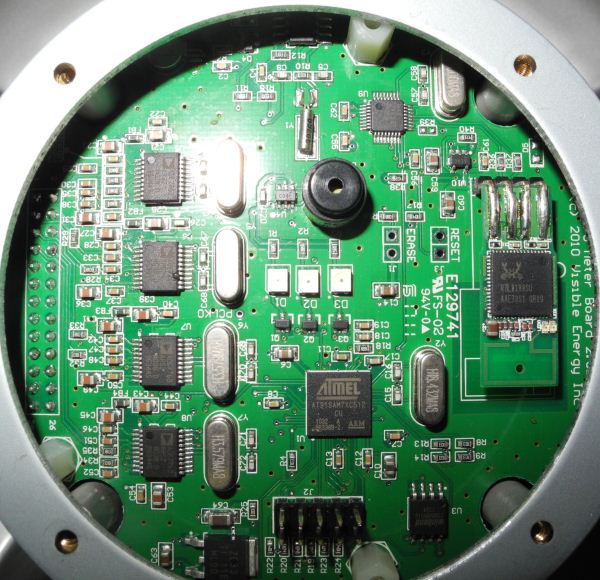Visible Energy UFO Power Center Smart Power Strip Review
by Ganesh T S on October 26, 2012 8:00 AM EST- Posted in
- Home Automation
- Wi-Fi
- Visible Energy
Hardware and Industrial Design
The industrial design of the UFO Power Center is definitely eye-catching, and may make for a good fit in some entertainment centers. Due to the non-standard design, it is sure to elicit polarizing opinions. Unfortunately, we are not great fans of the current size and shape of the unit. With a diameter of 12” and a height of 5”, it is too big to fit in most places where space is at a premium.
In addition, the clearance above and below the receptacles is not large enough for some ‘wall wart’ adapters, as shown in the photograph below (The adapter belongs to the Iomega EZ network attached hard disk). It is not possible to install the adapter with the output wire pointing downwards. Keeping the output wire pointed upwards (as shown below) makes it impossible to close the dome without dislodging the precariously positioned adapter from the receptacle.
Visible Energy has a blog post explaining the reason behind the size of the unit, and we will leave it to the reader to be the final judge.
Most of us are interested in the internals of the unit. Disassembling the unit exposed the following main components:
- 4x Schrack RT314F05 power relays, each of which is rated for 250V / 16A
- TI ULN2803A for switching the relay
- TNY278GN power switcher
- 4x ADE7763 energy metering ICs
- Atmel AT91SAM7XC512-CU microcontroller
- Realtek RTL8188SU 802.11b/g/n 1T1R WLAN Controller with USB 2.0 Interface
Despite being equipped with four relays capable of handling 16A each, Visible Energy has decided to play it safe by rating the whole unit for a maximum of 15A only.
A number of Wi-Fi companies (including TI, Qualcomm - Atheros and Marvell) have recently introduced a low cost system integrating the Wi-Fi radio and a MCU. Visible Energy currently uses two distinct chips for this, one from Atmel and the other from Realtek. The big vendors require complicated NDAs and large upfront payments. Given the projected low volume nature of the UFO Power Center (after all, it is Visible Energy’s first product) we actually need to applaud the company for choosing off-the-shelf components and making the entry price acceptable.
The Atmel microcontroller coordinates the operation of the unit as it sets up the ADE7763 chips for energy and power measurement. Power usage is computed and updated every second, while the energy usage is continuously monitored, but gets stored out once every five minutes. It also responds to the network requests from the Wi-Fi chip and sends back the requested data or modifies the relay status as applicable. The microcontroller also phones back home (to service.visiblenergy.com) with the energy / power data and socket status while also fetching any actions to be completed. These actions may have been set up by the user over the cloud interface. This pull mechanism enables control over the Internet without opening up any ports in the router for the unit. The downside is the fact that any change made to the socket status over the Internet could potentially take up to a minute to get reflected in the unit. Over the local network (for the iOS app / custom scripts using the open APIs), this is not a problem.
In addition, there are a number of other components such as a dedicated RTC (real time clock) and 1 MB of Flash memory for storage of energy history. This allows storage of the energy history of each socket for the previous 2 months at the minimum.
The LEDs and the Wi-Fi radio / miscellaneous board components contribute to a total power consumption of around 2.2 W even when nothing is connected to the sockets. By turning off the LEDs and the relays, it is possible to bring down the power to around 1.5 W.













35 Comments
View All Comments
Tros - Friday, October 26, 2012 - link
I don't see how choosing a 16A relay for each socket is "playing it safe". Maybe a >21A relay would be considered "playing it safe" (for the small-uninformed-population running a MIG-welder from a wall-socket).A 15A relay would mean that the manufacturer has to do some additional QA to handle the statistics in which relays actually fall short of that rating (and consequently, that 15A rating which is the basic standard for wall outlets here in the U.S.).
This is playing it according to specification.
jb510 - Sunday, October 28, 2012 - link
Is it possible to remotely tell it to power cycle a device? ...and specifically the wifi router it's relying on for control? Just to be painfully clear manually turning that plug back on after turning it off would be impossible since there'd be no wifi at that moment, so im wondering if you can just send a single command to power cycle a outlet off and back on?ganeshts - Monday, October 29, 2012 - link
Power cycle is not possible with the current firmware, and I would also advise against using one of the outlets for the Wi-Fi router itself. For such purposes, PDUs from Digital Loggers can be used because some of the outlets in their devices are left unswitched (i.e, they are on all the time as long as the PDU gets power) / they offer power cycle functionality.rangerdavid - Sunday, October 28, 2012 - link
"I am actually doing a bit of disservice to the unit by not reviewing the iOS app, as I have never been a fan of (nor do I ever plan on being one) Apple’s restrictive ecosystem."Who gives a ---- about this - review the app, or don't. The app is the app. Don't penalize it for being available on an iOS device just because you don't like Apple's "restrictive ecosystem." So restrictive that 200,000+ apps just appeared out of thin air?
I'd say this is a cheap shot and lame excuse not to post a page about the app.
Otherwise, this is a great article. I'm just calling you on this one issue. So there.
valkator - Thursday, November 1, 2012 - link
Sweet, I can hook up all my devices to this unit and it can be my dogs water bowl. :)^ Joke